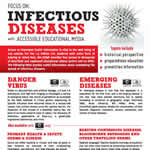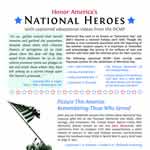


In this issue: |
SURVEY OF TVI | DB AWARENESS WEEK | HAWAII |
skip to quick hits
DCMP Completes Survey About Video Usage Among TVIsBack to article listing
How many teachers of students with visual impairments (TVI) utilize video in their classrooms? How many of these videos are described? Are teachers even aware that described videos are available or how to locate them? We asked these questions (and a few more) as part of a survey of TVIs conducted over the last month and were impressed with the overall number (and quality) of the responses. While a more formal journal publication of the survey results is in development, here are some of the encapsulated data: 86% of the respondents are familiar with the concept of description, and 45% use video in their classrooms. Responses were almost evenly split between public school teachers (49%) and residential school teachers (43%), with a handful of private, charter, and alternative school teachers making up the difference. Of teachers who use video in their classrooms, 71% report that few (less than 25%) to none of the videos they use in class are available with description. In contrast, 5% reported that they won’t use video unless it’s described. What about those teachers who don’t use video in their classroom? We found that, while there was no majority reason given, a plurality (28%) reported that they were unable to find accessible video for their classroom. Thankfully, only 5% of these respondents reported that video is not an appropriate learning medium for students with visual impairments, and 81% said that they would begin to use video in their classrooms if more was made accessible. Stay tuned for a future edition of the DCMP newsletter with information about the complete survey results. Until then, we hope you keep spreading the word to teachers, parents, and other professionals about the DCMP’s collection of accessible videos! Deaf-Blind Awareness Week: June 21–27Back to article listing
Join in the celebration of a legend in the field of deaf-blindness, a champion of human rights, and an inspiration to millions around the world: 2009’s Deaf-Blind Awareness Week theme is “I am Helen Keller.” According to the Helen Keller National Center for Deaf-Blind Youths and Adults (HKNC):
Don’t forget that we recently added the Emmy Award–winning 1979 production of The Miracle Worker to our collection of captioned and described videos. We’ve heard from many teachers and parents of students who are deaf-blind who were thrilled to learn that this timeless classic was added to the collection. Be sure to share it with your students as well, especially in light of the upcoming deaf-blind awareness week observation! You may also For more information about Helen Keller, visit the American Foundation for the Blind’s (AFB) Helen Keller Archives. (AFB also provides a “Helen Keller Kids Museum” on its Braille Bug website.) For more on deaf-blindness, visit the National Consortium on Deaf-Blindness as well as the leading consumer group for people who are deaf-blind, the American Association of the Deaf-Blind. Read Captions Across Hawaii!Back to article listing
There is a Hawaiian saying: “E lauhoe mai na wa`a; i ke kâ, i ka hoe; i ka hoe, i ke kâ; pae aku i ka `âina,” which means: “Everybody paddle together; bail and paddle; paddle and bail; and the shore is reached.” Well, there is some great news from the Aloha State! Many captioning advocates have been paddling together for some time, and the shore is in sight! The Hawaii Senate [PDF] and House [PDF] recently passed resolutions that encourage parents and business owners to have captioning on whenever a child is watching television. In the resolution, it is noted: … [T]he Legislature urges all public and private agencies to encourage their parent clients to turn on closed captioning while their children watch television… We’re thrilled by this resolution. For years, we have been working to promote the tie between reading captions and improved literacy [PDF], and now Hawaii has recognized and acknowledged the benefits of captioning as a literacy tool. Because people of all ages—regardless of whether they have a hearing loss—can improve their literacy skills by reading captions, Hawaii’s encouragement is in the long-range best interest of the public, and we’re hoping to see similar resolution in the future here on the mainland! Aloha! |

ACCESSIBLE INFECTIOUS DISEASE INFO FROM THE DCMPWith the summer flu season in effect—and the recent outbreak of H1N1 Flu in virtually every U.S. State—equal access to important health information is vital. The DCMP has several videos available to its members. Check out a new flyer [PDF—pictured below] from the DCMP for recommendations of titles about infectious diseases and how they might be prevented. 


CAPTIONED MEDIA FOR MEMORIAL DAYCheck out another new flyer [PDF—pictured below] for some recommended captioned titles from the DCMP collection that will add to your students’ understanding and appreciation regarding why we celebrate Memorial Day. 


HOW TO SPOT AND STOP ABUSENo one should ever experience abuse, whether physical, emotional, or verbal. However, the challenges faced by today’s teens place them at a heightened risk of abuse, a problem that seems to grow worse every year. A new article [PDF] by DCMP Communications Editor Kelly Gorski, written for teens, examines this issue and provides information to empower young adults to take the necessary action to protect themselves. 

BETTER HEARING AND SPEECH MONTHBetter Hearing and Speech Month is an annual event to raise awareness about communication disorders and to promote treatment that can improve the quality of life for those who experience problems with speaking, understanding, or hearing. Read an article [PDF] by DCMP’s Erma Belz about the benefits of early childhood hearing screenings and her experiences with hearing loss. Also, check the DCMP catalog for titles with information about cued speech, hearing disorders, and more. 
|
|
The Described and Captioned Media Program is funded by the U.S. Department of Education and administered by the National Association of the Deaf. |
Visit the DCMP Website |
The contents of this newsletter were developed under a grant from the U.S. Department of Education, Cooperative Agreement #H327N060002. However, those contents do not necessarily represent the policy of the U.S. Department of Education, and you should not assume endorsement by the Federal Government. Project Officer, Ernest Hairston.


 purchase The Miracle Worker
purchase The Miracle Worker